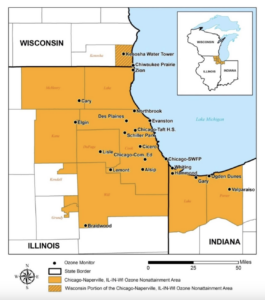October 19, 2023
US EPA Must Require Indiana to Reduce Smog
State agency ignored most of ELPC’s comments on its insufficient smog plan. Indiana needs new control measures to reduce ozone levels in an area plagued by unhealthy air quality.
 The northern portion of Lake and Porter Counties in Indiana have unhealthy levels of ozone each summer, also known as smog, according to air monitoring conducted by EPA. As a result, the Indiana Department of Environmental Management (IDEM) is required to submit a plan to EPA showing how it will lower ozone levels in this far northwestern portion of Indiana closest to Chicago.
The northern portion of Lake and Porter Counties in Indiana have unhealthy levels of ozone each summer, also known as smog, according to air monitoring conducted by EPA. As a result, the Indiana Department of Environmental Management (IDEM) is required to submit a plan to EPA showing how it will lower ozone levels in this far northwestern portion of Indiana closest to Chicago.
ELPC submitted comments to IDEM explaining why its plans were inadequate and attended a public hearing in June 2023 where dozens of local residents expressed their concern about local air quality. Despite these pleas, IDEM submitted an “Attainment Document” to EPA offering to take no new control measures to improve air quality. On September 14, 2023, ELPC wrote to EPA asking that it scrutinize IDEM’s Attainment Document for the reasons expressed in our original comments and for two new reasons:
Ozone Levels are Increasing in Lake and Porter Counties
Ground-level ozone, most commonly known as smog, is one of the six criteria air pollutants for which the EPA sets National Ambient Air Quality Standards (NAAQS), which are used to specify the maximum allowed measurement of smog to be present in outdoor air.[1]
Smog is formed when nitrogen dioxide (NOx) and volatile organic compounds (VOCs) are emitted from cars, power plants, industrial boilers, refineries, chemical plants, and other sources and react with each other in the presence of sunlight.[2] Exposure to smog can have negative health impacts, including causing breathing difficulties, inflammation and damage to airways, aggravating lung diseases like asthma, and increasing the frequency of asthma attacks.[3]
According to EPA’s air quality monitors in Lake and Porter Counties, ozone levels during the summer of 2023 were at or significantly above the NAAQS for an 8-hour average, which is 0.070 ppm, further demonstrating that ozone levels are increasing.
Hammond: 0.070
Gary: 0.076
Valparaiso: 0.072
Ogden Dunes: 0.076
IDEM’s Acknowledges That its Estimate of Future Emissions is Low
IDEM recently updated its estimate of emissions from motor vehicles (available here). This update shows that more recent modeling increases the future emission estimates for NOx and VOCs from motor vehicles for the years 2030 and 2035. As a result, Indiana has even further to go to reduce ozone to healthy levels, underscoring the need to take action now to reduce future emissions.
What’s Next
EPA will decide whether IDEM’s plan satisfies the Clean Air Act’s obligation to implement control measures to reduce ozone levels to healthy levels. ELPC and the Northwest Indiana community will monitor these actions and continue to encourage State and federal officials to take concrete actions to ensure healthy air in the Region.
[1] https://www.epa.gov/ground-level-ozone-pollution/setting-and-reviewing-standards-control-ozone-pollution
[2] https://www.epa.gov/ground-level-ozone-pollution/ground-level-ozone-basics#formation
[3] https://www.epa.gov/ground-level-ozone-pollution/health-effects-ozone-pollution


